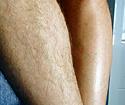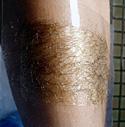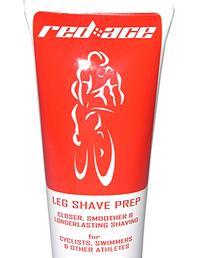
Recently on Cyclingnews.com |
On test: Blue Steel & Red Ace hair removal products, June 22, 2005
To uproot or not to uproot?
Cyclists the world over prefer "nude", hairless legs for various reasons. Dave Langley explores the path to hairless legs via Blue Steel and Red Ace hair removal products.
|
Having spent 10 odd years with shaven legs, over the last few years I've taken a break from racing and have let the fields grow fallow. I must say that the whole weekly ritual of leg shaving is not something I miss. Whether my friends were embarrassed to be seen riding with me, or simply wanted vengeance for past insults, I have been singled out as a suitably hairy guinea pig for hair removal via waxing (sounds grizzly), chemical treatment (sounds nasty), and plain old shaving (no sweat until you cut yourself on those knobbly parts you became blase about).
In theory, then:
Waxing
Pros: The entire hair follicle is removed. It takes several weeks for
a new hair follicle to get growing and show itself. The new hair is thinner,
and more easily removed upon subsequent waxing, which takes place about every
six weeks.
Cons: The ouch factor.
Creaming (aka "chemical method")
Pros: Just smooth on the hair removal cream and wait 10 minutes before
removing cream residue and hair. Too easy! Good for areas otherwise difficult
to wax or shave.
Cons: The smell!
Shaving
Pros: Method used by most cyclists as it is fast and simple. Is typically
done once a week or to taste.
Cons: The spiky little stump shows itself immediately and starts to
grow with vengeance. Is typically done once a week. Cuts, especially on the
knobbly bits and areas where the bone is right under the skin.
Abstinence
Pros: Actually, there are some benefits to be reaped by not doing anything
at all. Being hairy legged allows for a certain degree of anonymity - no one
in the bunch expects you to perform when you are obviously either a novice or
an over-the-hill cycling bumbly.
Cons: Bad if you need a massage as the hairs get pulled and infected.
Bad if you come off as, once again, even if an area of skin doesn't physically
graze, most of the hairs in the area get pulled and infected. Looks very unprofessional.
The Test
With two legs available, I decided to wax one, and level the other with a combination of the chemical treatment and standard shaving.
Waxing: Blue Steel Sports Wax Strips

|
Waxing ones legs is a concept I've never felt particularly comfortable about. Advantages are that once the hair is removed, the procedure should not have to be repeated for another six weeks or so. Sounds great... up to the point of actually having to do it. While women in the audience might scoff, uprooting acres of male leg hair is akin to pulling Sequoia pines in comparison to the saplings which inhabit most women's legs. I expected the procedure to be stressful and painful and was not disappointed. It can, however, provide considerable entertainment for both yourself and your partner (moral support) if you don't take it all too seriously. Sharing the experience will earn you either scorn or sympathy.
Procedure
Some preparation was required for legs as hairy as mine. This involved first running a clipper (number 1 setting) over the target area (entire leg) in order to shorten the hairs to an approximate length of 0.5 to 1 cm. Having procrastinated with the clippers, time for the waxing. The strips of wax lie between plastic films which, after gentle warming in ones hands, separate to produce two wax strips. The waxed side of the still-warm strip is then smoothed over the target area before you rip like HELL. You've done a sterling job if you manage to denude the entire area under the wax. More often than not though, coverage was not totally complete, and required repetitions in order to get all of the little buggers. Somehow I managed to giggle and grimace my way through most of my left leg. In spite of the brevity involved with each strip's removal, it still took me the best part of an hour to achieve. With the lion's share of hairs removed, a razor took care of those left behind.
I'm not sure if it was due to my unfamiliarity of the technique, or the dread of the RIP, but the technique did prove to be more time consuming than I envisaged. Having done half the leg the novelty had definitely worn off, and a bit of a psychological battle had to be won in order to finish the job - it was somewhat disheartening knowing how many yelps were yet required. Maybe beer would have helped. Maybe the fairer sex is right? Maybe I'm just a wuss and lack the intestinal fortitude required for this sort of caper.

|
Each pack contains 15 units which separate to yield 30 strips. I went through about 8 units to (mostly) finish one leg. So one packet should be sufficient to do two legs, although I suppose it depends upon how long your legs are. With a little practice I'm sure you can make them go a little further.
I suspect (hope) that this is the sort of procedure is a rough trade that first time, but becomes progressively easier as new "baby" hairs emerge softer and more easily uprooted. Jury out on this but if I can be persuaded to follow up in a month's time, maybe I'll let you know. As for how this "do it yourself" approach compares to the ruthless ladies in the hair removal salons, some serious arm-twisting might have to ensue before I'm ready for that challenge.
A female Cyclingnews tester who tried the Blue Steel strips describes them as "brilliant" as long as you pick up on a tip in the instructions and warm them with a hair dryer first, rather than just your hands. It also helps to pull the skin down as you pull the strip up, to keep the skin and hair taught.
Price: Au$19.95
Pros: Effective, especially if you warm the strips
Cons: Ouch!
More information: www.bluesteelsports.com.au
Cyclingnews Ratings: ![]()
Creaming: Blue Steel Hair Removing Lotion
The two active ingredients in this lotion are calcium hydroxide and calcium thioglycollate. Both act to effectively dissolve the hair and loosen its mooring to the skin. Being a bit of a chemist, here's my take on what the calcium hydroxide and calcium thioglycollate actually do. Those who glazed over in high school chemistry can just skip to the procedure, below.
Calcium hydroxide: This salt is fairly insoluble in water and is probably largely responsible for the white paste-like appearance of the cream. The hydroxide anion is the bit that does the business. The presence of hydroxide results in the cream being highly basic (alkaline pH). Alkaline conditions are good for the hydrolysis (chopping up) of ester-linked oils (that is, fats and cell membranes) and in this case, the peptide bonds which are the glue holding proteins together. A similar chemical you might be familiar with is sodium hydroxide, solutions of which feel slimy to the touch as the hydroxide rapidly dissolves the fats in your skin. Incidentally, sodium hydroxide is one of the active ingredients in products used to clear blocked kitchen and bathroom sinks and drains, which become plugged with hair, food and God knows what else.
The pH of the cream is in the order of 13 (7 being neutral), which is roughly as basic as gastric juice or lemon juice is acidic (pH ~1.4 and 2.3 respectively). For most people, this extreme of pH is not severe enough to cause irritation of or burn your skin, but you are advised to check whether this is the case by applying some cream to a small sample of skin first. In order to understand what happens, you need to appreciate that hair is predominantly made of a protein called keratin. Keratin molecules normally wrap about each other in a helical manner to form strong cable-like fibres, which again wrap about each other to form strong animal hairs.
[What are proteins? Proteins are the large molecules that constitute the structural components of the cells in your body. Each is a linear polymer of building blocks called amino acids, of which there or 20 different types. Each individual protein comprises a certain number of amino acids, joined in a particular order via links called "peptide bonds". The human genome has approx 30,000 genes, each of which directs the synthesis of a unique protein with a specific functional role. Each unique protein has a particular "fold" or three-dimensional structure, dependant on the number and sequence of amino acids, which enables the protein to do a certain job in the cell.]
Two things happen to proteins exposed to alkaline environments. Firstly, at such a basic pH, the unique three-dimensional structures of most proteins unravel into random spaghetti-like molecules with no structural integrity. Biochemists say the proteins become "denatured". Hence, in this case, the keratin fibres start to unravel. Secondly, the peptide bonds which connect the amino acids are prone to hydrolysis (breakage). The overall result is that the keratin molecules start to not only unravel from each other but get chopped up, enabling the hair to gradually fall apart and dissolve. Unsurprisingly, calcium hydroxide is used commercially for the removal of animal hair from hides.
Calcium thioglycollate: This is the component that gives the cream that special rotten-egg-gas stink. The thioglycollate anion contains a free sulfhydryl group which acts as a reducing agent. As it turns out, the keratin strands alluded to above are also cross-linked to one another via "disulphide bonds" for extra strength and stability. When you get a perm at the hairdressers, you are chemically breaking these sulhydryl links, straightening or curling the hair fibres, then re-forming the sulfhydryl links, setting your adopted style in place. Similarly, the disulphide bonds are broken (reduced) by the sulfhydryl groups of the thioglycollate molecules. With the cross-links broken, the protein strands are more easily separated from each other and dissolved.
The combination of alkaline and reducing conditions presumably both partially dissolves the hair, and weakens its resolve to stay rooted in the skin.
Procedure
Smooth cream on heavily, then let sit for 10-15 minutes as you read the paper or listen to the radio - anything to take your mind off the smell. I must confess I was skeptical as to whether this was going to work. After 10 minutes I was convinced it hadn't. Nothing seemed to come away when the treated area was put briefly under a tap. However, when wiped firmly with a damp cloth - bingo! - the hairs ripped away en masse. Too easy! No pain, just a rotten smell that takes considerable washing to remove. Some of the hairs seemed to have been removed from the root, others at variable heights, but predominantly close to the skin. The coverage I attained was reasonable but not complete, perhaps indicating that I had been too sparing with the cream. Thicker hairs seemed more reluctant to go than thinner hairs. As with waxing, stragglers and missed corridors were removed with the good old razor.
Prices: AU$14.95
Pros: Easy; good excuse for a chemistry lesson
Cons: The smell!
More information: www.bluesteelsports.com.au
Cyclingnews Rating: ![]()

|
Shaving: Red Ace Leg Shave Prep
A tried and tested method. After suffering cuts the first few times, you quickly learn the idiosyncrasies of your anatomy and usually manage without any damage.
Procedure
Just lather up and go for it. This particular shaving cream claims to enable "closer smoother and longer lasting shaving". It contains a range of detergents and moisturisers not too dissimilar to what is contained in other shaving creams. In most instances, if I lather up an entire leg, by the time I'm half way through the remaining areas are starting to dry a little, requiring re-lathering with a brush in order to keep the razor gliding smoothly. As I only had half a leg to do here, it was impossible for me to make a judgment as to whether this formulation of shaving cream would keep the lathered area moister for longer. My guess would be that it would behave in a similar manner to most other shaving creams that you lather-up yourself. The consistency of this preparation was more liquid than other brands, perhaps suggesting that it is not as concentrated. I'm wondering whether you will get as much bang for your buck as what you might be using now. Having said that, this product did effectively lubricate the skin and do the job effectively.
Prices: AU$9.95
Pros: Still the simplest method.
Cons: Perhaps a bit thin
More information: www.bluesteelsports.com.au
Cyclingnews Rating: ![]()
Summary
Short of laser surgery, waxing, creaming and shaving are the available options for hair removal. Call me old fashioned, but at this stage of the game I think I'll stick with the trusty razor. Neither waxing nor creaming worked quite as completely or easily as I was expecting, leaving me to finish up with a razor anyway. Maybe if i were a full-time athlete the waxing or creaming would be a better option. It's a very personal choice. If you are dissatisfied with your current regime and suspect that there must be a better way, be bold, be brave, and give either waxing or creaming a whirl.


